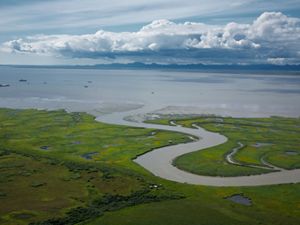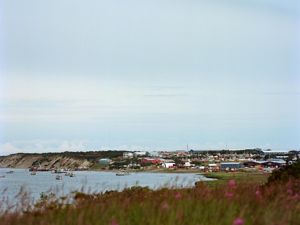The Nature Conservancy in Alaska’s growing public policy team celebrated a significant win for Alaska’s emerging renewable energy sector following the close of Alaska’s 2024 legislative session.
TNC engaged at the right time, with the right people and with the right research to successfully advocate for creation of a statewide green bank, dubbed the “Alaska Energy Independence Fund.” Housed at the Alaska Housing Finance Corporation, the fund will facilitate renewable energy and energy-efficiency projects statewide.
Alaska’s Limited Infrastructure Means Energy Use is Inefficient and Expensive
As a result of its great size and cold winters, Alaska has some of the highest energy costs and per capita rates of energy consumption in the world. Retail electricity consumers in Alaska pay nearly double the U.S. average price per kilowatt hour. Rural communities often rely on diesel generators for power. That’s why advancing renewable energy solutions in Alaska has an outsized impact on people’s lives and Alaska’s greenhouse-gas emissions.
The green bank bill was designed to:
- Help lower energy costs around the state, which will lower the cost of living while incentivizing business investment;
- Improve the viability and affordability of renewable energy projects;
- Decrease greenhouse-gas emissions;
- Improve community resilience by diversifying energy sources—from rural communities dependent on diesel fuel to population centers facing natural-gas shortages.
Policy Wins in Alaska Make Major Impacts
In a state with 660 million acres—85% of which are public—political engagement is one of our most powerful conservation tools.
Prior to the 2024 Alaska legislative session, TNC Alaska Director of Government Relations Kelsey Schober identified the green bank bill as a priority. At the same time, Schober was building her team, more than doubling Alaska’s policy muscle. With new capacity, fresh research and clear priorities, it was time to make a move.
Research Laid the Foundation
Through a multi-year partnership with Alaska-based McKinley Research, The Nature Conservancy in Alaska worked to document the opportunities in Alaska for responding to climate threats with foresight and smart planning. Formal research skillfully circulated to lawmakers helped highlight some of the most pressing issues facing Alaska as it relates to climate change.
In 2021, TNC Alaska commissioned a series of four reports from McKinley Research, called the “Alaska Climate Opportunities Assessment.” They broke down as follows:
In March of 2024, TNC Alaska again hired McKinley Research to prepare a study specifically looking at green banks, and within a few months, Alaska’s first green bank became official.
‘Dogged’ Commitment Made it Possible
The green bank bill didn’t pass until 11:30 p.m. on the final night of the legislative session, making it clear that TNC’s advocacy was critical to its success.
“The green bank bill seemed destined to be forgotten, but we were dogged about not letting it die,” recalled TNC Alaska Government Affairs Manager Sommers Cole. “We did our best to reinvigorate the conversation and built momentum to get it across the finish line by leveraging strategic partnerships.”
The passage of this bill is a great example of how policy can make significant conservation impacts in a way our other work can’t, helping to scale conservation for people, nature and the economy in this great, big state.
Latest News in Alaska
Sign up to receive monthly conservation news and updates from Alaska Get a preview of Alaska’s Nature News email.





